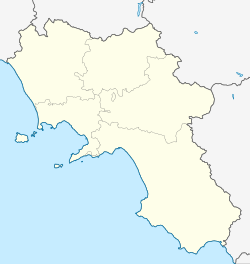world.wikisort.org - Italy
Bacoli (Italian pronunciation: [ˈbaːkoli]; Latin: Bauli)[3] is a comune (municipality) in the Metropolitan City of Naples in the Italian region Campania, located about 15 kilometres (9.3 mi) west of Naples.
Bacoli
| |
|---|---|
Comune | |
 Bacoli | |
 Coat of arms | |
Location of Bacoli  | |
 Bacoli Location of Bacoli in Campania  Bacoli Bacoli (Campania) | |
| Coordinates: 40°48′N 14°5′E | |
| Country | Italy |
| Region | Campania |
| Metropolitan city | Naples (NA) |
| Frazioni | Baia, Capo Miseno, Cappella, Cuma (partial), Faro, Fusaro, Miliscola, Miseno, Scalandrone, Torregaveta |
| Government | |
| • Mayor | Josi Gerardo Della Ragione (Freebacoli) |
| Area | |
| • Total | 13.3 km2 (5.1 sq mi) |
| Elevation | 30 m (100 ft) |
| Population (28 February 2017)[2] | |
| • Total | 26,413 |
| • Density | 2,000/km2 (5,100/sq mi) |
| Demonym | Bacolesi |
| Time zone | UTC+1 (CET) |
| • Summer (DST) | UTC+2 (CEST) |
| Postal code | 80070 |
| Dialing code | 081 |
| Patron saint | St. Anne |
| Saint day | July 26 |
| Website | Official website |
Geography
Bacoli borders the municipalities of Monte di Procida and Pozzuoli.
Its territory, of volcanic origin, is part of the Phlegraean Fields. The volcano of Cape Miseno and the Miseno port date from c. 35,000-10,500 years ago.
History
Bacoli was founded by the ancient Romans in the 2nd or 1st c. BC, who called it Bauli. In Roman times it was a popular resort almost as famous as the nearby Baiae. Many luxurious villas were built on the coast there and on the headland. Symmachus said of Bauli in the late 4th c. AD:
"I left that place because there was a danger that if I became too fond of Bauli, all the other places I have left to see would not have pleased me".
Main sights
Several major ancient Roman structures can be seen in Bacoli, including the Piscina Mirabilis, the Cento Camerelle, and the so-called Tomba Agrippina, a theatre belonging to an ancient villa.
The frazione of Cuma - Fusaro includes the site of Cumae, the first settlement in Italy by the ancient Greeks.
The archaeological remains of Baiae are also located in the comune.
The frazione of Miliscola (from the Latin militum schola) was, in the Roman Empire, the seat of a military school
Twin towns
References
- "Superficie di Comuni Province e Regioni italiane al 9 ottobre 2011". Italian National Institute of Statistics. Retrieved 16 March 2019.
- All demographics and other statistics: Italian statistical institute Istat.
- Richard Talbert, Barrington Atlas of the Greek and Roman World, (ISBN 0-691-03169-X), Map 44 & notes.
- "Official website, twinning" (PDF). Archived from the original (PDF) on 2016-03-04. Retrieved 2016-07-20.
- "Dipartimento Della Protezione Civile : Relazione" (PDF). Senato.it. Retrieved 7 March 2022.
- "Napoli in gemellaggio con Kobane: "Vicini a chi lotta per la pace e la libertà"". Napolitoday.it. Retrieved 7 March 2022.
External links
На других языках
[de] Bacoli
Bacoli ist eine Gemeinde mit 26.112 Einwohnern (Stand 31. Dezember 2019) in der Metropolitanstadt Neapel, Region Kampanien. Die antiken römischen Badeorte Baiae (Ortsteil Baia) und Bauli befanden sich auf dem Gebiet des heutigen Bacoli.- [en] Bacoli
[es] Bacoli
Bacoli es un municipio italiano localizado en la Ciudad metropolitana de Nápoles, región de Campania. Cuenta con 26.404 habitantes[3] en 13,47 km².[it] Bacoli
Bacoli (Vàcule in napoletano[4]) è un comune italiano di 25 126 abitanti[1] della città metropolitana di Napoli in Campania.[ru] Баколи
Баколи (итал. Bacoli) — город в Италии, располагается в регионе Кампания, в провинции Неаполь.Другой контент может иметь иную лицензию. Перед использованием материалов сайта WikiSort.org внимательно изучите правила лицензирования конкретных элементов наполнения сайта.
WikiSort.org - проект по пересортировке и дополнению контента Википедии
